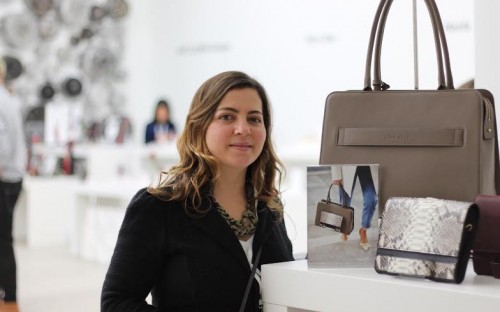The winds of change are sweeping over the luxury industry, battering at the gilded gates of some of the world’s top brands and opening up new opportunities for MBA entrepreneurs.Nowhere is the clash between old and new felt more than in the luxury sector. In an industry where history and heritage is everything, entrepreneurs with new brands typically face an uphill struggle.
Louis Vuitton, the most valuable luxury brand in the world, was founded 150 years ago. The 179 year-old Hermès is valued at $19 billion; 95 year-old Gucci at $13.8 billion.
Yet the times they are a changin'.
“The big brands are not as secure as they used to be,” says Esin Akan, an EMBA graduate from London Business School, who launched her eponymous luxury label selling fully-customizable handbags. “Contemporary brands are getting more market share every day,” she says.
Despite competition from century-old brands like Prada and Burberry, Esin Akan has enjoyed constant growth since it launched in 2012.
“People don’t want to identify themselves with big brand names or logos anymore,” Esin says. “They want to be more unique, more contemporary.”
Behind the consumer shift is “a new wave of ‘new rich’”, according to Nyachia Knight, an MBA graduate from France’s EMLYON Business School who started up her own luxury events company.
“They are younger, more international and they want to be seen as first movers. So they spend more money to keep up this appearance,” she says.
This trend is especially visible among Chinese consumers who, according to a 2015 Bain & Co report, account for 31% of global luxury sales.
“There’s a growing upper-middle class with an interest in new designers,” says Esin, “so there’s definitely an opportunity for the future.”

With this in mind, Lily Wang, an MBA graduate from Italy’s MIP Politecnico di Milano, started up her own business connecting luxury start-up companies and investors in Asia to Europe.
For Lily, pictured left, the dawning digital era is fuelling the transformation of the luxury sector and opening up more opportunities for aspiring entrepreneurs. “Consumer behavior is changing in line with the digital world,” she says.
According to a 2014 McKinsey report, 40% of luxury purchases are in some way influenced by consumers’ digital experience.
Online marketplaces, which sell luxury products for commission, are now focusing more on contemporary rather than established brands. Esin’s main focus is online sales. “For me, that’s the future,” she says.
While many leading luxury brands have been slow to adapt to the digital era, Burberry was amongst the first to expand into new markets through its use of mobile-based social media platforms like Instagram and Snapchat.

While he accepts that digitization brings huge marketing benefits, Sebastian Kumeth, an MBA graduate from Grenoble École de Management, thinks that new online channels have their limitations.
“The internet is a nice platform to promote your brand but it doesn’t necessarily bring you the sales in the end,” says the Bavaria-born entrepreneur, pictured right, who set up his own high-end coat brand, KUMETH, in October 2014.
“If you charge a lot of money for something, at some point it has to be justified,” he continues. “It’s very hard to justify it online with a photo rather than showing it to a customer.”
On one hand, the internet is fuelling a trend towards affordable luxury. Glam Squad is a New York-based, on-demand beauty provider, which delivers professional in-home beauty services for a fraction of the normal cost.
Sharing economy ventures, too, are allowing people to enjoy luxury experiences for less. One Fine Stay is like a high-end Airbnb giving holidaymakers access to luxury penthouses in exclusive areas in London, Paris and New York, while Social Flights lets users book on to unused seats in private jets.
Yet the demand for high-end products remains.
“There’s a trend of people going back to quality rather than paying premium for a brand,” says Sebastian. “People look at our collection and say that the quality we offer is something that they haven’t seen for a long time.”
Student Reviews
Intense courses, helpful professors
I am an international student in my 3rd year and I love going to this school and do not regret chosing it for my BBA.
The classes are helpful, professors are always there to help as well and we have a very understanding administration.
Leadership in an amazing city
I decided to do my exchange in Emlyon because I wanted to get out of my comfort zone, and I found a space with very capable People.. participatory, empathetic and full of leadership. I will never forget Lyon, apart from giving me an unforgettable experience, he gave me great friends
A lot of opportunities professionally and socially. A unique program in France.
You can choose your courses and do your internship, exchange whenever you want. It's flexible and adapted to the needs of each student. A great program and a great city! Professionally, it opens a lot of doors for you to find internships or jobs in France or abroad thanks to the network and career events.
MSc in Digital Marketing
Combining both worlds into one, this course gave me all the on-demand technical skills in data science while maintaining a business-oriented approach. Thanks to the strong academic profile of this university I was able to secure an internship and full-time job at Amazon.
Top Business School fostering innovative entrepreneurs
EMLyon is one of the best business schools. The campuses, associations and courses offered provide the students with the best options to build the future they have chosen. The various opportunities to study and work abroad also offer a deeper understanding of the world, not only economy-wise but social, which helps the student become as well a better individual and not only a pre-formated business school student.
Emlyon campus in Paris
It has a great international community and you have access to many international tools, courses and professors. I had many networking events and workshops for students. Campus and some details of the program could have been improved or need to be bigger in order to have a better student life.
Entrepreneurship
Overall good content and good activities.
Lack of administration but still ok.
Good flexibility and liberty offered to the students. Finally, the amount of internship is also a good way to improve qualifications.
Good Reputation and International Business School
The course was not well adapted but it was up to the mark.
The professors are very well experienced and their experience comes in handy while working on assignments.
The facilities on the campus are top class. Truly professional. I really like spending time in the learning hub and using all the available resources.
Lyon is an amazing city. You will never get bored.
MSc International Hospitality Management
The best educational experience of my life so far!
It’s been full of exposure and great connections. From Lyon to London, Paris, Los Angeles and Las Vegas! Truly an exceptional way to discover the world of hospitality.
Real networking opportunities
- meeting new people, specially professionals during seminars or evening meeting at school.
- going abroad to study luxury
- being involved as an ambassador to promote the school and the program I was into (MSc LMM)
- having such a great professional core
white baccalaureate in the world of work
I really appreciated the MS SDAI as a whole. The teaching staff, the different subjects, the university exchange, TEM... I started my internship in a consulting firm having acquired a solid foundation. Downside for CentraleSupélec, which I found far too academic for a program such as this.
Great
Pretty great !
Emlyon business school is a top educational institution known for its outstanding academic programs, nurturing environment, and state-of-the-art facilities. It fosters creativity, critical thinking, and leadership in students.
Emlyon makes us confident!
Since I got into emlyon business school in September 2024, I’ve had many occasions to discover various subjects, but also to gain confidence and strength in several fields. Our « ADN » classes involve active participation and teamwork which enlighten our everyday life here in Lyon.
Teachers are welcoming and available, classes are dispensed in small rooms, all of this turning our studies into a real life experience.
As a top business school in France and in Europe, rest assured that this programme will take you to places you never had the chance to go to.
Worldwide School
If you're looking for a school with an international perspective, emlyon is the place to be. Academic exchange and double-degree opportunities are widely varied around the globe, and the school has 4 international campuses.
Warm welcome
emlyon is one of France's top business schools, offering a wide range of programs and masters degrees that allow students from all backgrounds to perfect their skills. Students are very friendly and student life is dynamic with 42 associations (art, culture, finance...). With the inauguration of its new campus, the school also offers students a highly advantageous working environment right in the heart of Lyon.
Experience at emlyon
My experience in emlyon business school was nothing but fantastic. The professors are very knowledgeable and helpful and are the best in the field to guide you to build your future self. The campus life is also really great and you get to meet amazing people!
A Global and Data-driven Learning Experience
As an international student from Taiwan, currently studying Digital Marketing & Data Science at Emlyon Business School's Paris campus, my experience has been both challenging and rewarding.
1. Academics & Curriculum
The program is highly data-driven, integrating real-world marketing strategies with technical skills like Python, SQL, and machine learning. Professors bring industry expertise and often collaborate with companies, making classes interactive and practical.
2. Campus & Student Life
The Paris campus is a great location for networking, surrounded by top companies and start-up ecosystems. There are plenty of career events, hackathons, and networking opportunities, which have helped me connect with professionals in my field.
3. International Student Experience
Coming from Taiwan, Emlyon provides a diverse and global environment. The school supports international students well, but navigating administrative processes (like visas and housing) can sometimes be challenging. However, the student community is welcoming, and there are many activities and student initiatives to engage with.
4. Overall Impression
I think Emlyon is a great choice for students looking for an innovative, hands-on learning experience in business and technology. While some courses could benefit from even more structure, the real-world projects, industry collaborations, and international environment make it a strong business school for aspiring digital professionals.
Very Good Program and Life-Changing Opportunities
I was truly delighted with my program as it provided me with valuable knowledge and skills. The campus is outstanding, offering an inspiring and welcoming environment for students. Moreover, my program opened up new professional opportunities that I would never have been able to access without completing this Master's degree in Strategy in International Business Development (in partnership with CentraleSupélec). I highly recommend this school to anyone seeking a transformative academic experience!
BBA1 EM Lyon business school
This is my first year at EM Lyon and one of the first factors that makes me love my school is its campus. The location, the layout of the premises, the exteriors... all the facilities are functional and largely allow students to flourish in their studies (very large library, individual and collaborative workspaces, fully equipped rooms that can be booked, catering and relaxation areas, roof... everything is there!) Also, what I particularly appreciate is the format of the courses which combines practice with theory. My program is intended to be very professionalizing, so we have courses and modules that put us in real situations, the professors and external speakers are for the most part people in professional activities in companies which allows us to benefit from concrete illustrations and notable anecdotes. The classes are not very numerous, offering us an opportunity for interaction and group work. In addition to the courses, the school has many very advantageous partnerships for internships and academic exchanges. In addition, the school offers many conferences and workshops at the Makerslab that allow us to educate ourselves and learn new things. Finally, my program is internationally oriented and that is one of the reasons why I chose it: internships and academic exchange abroad. Finally, student life is a real added value for us since the associative life occupies a preponderant place in our course due to the variety of associations, the premises that are reserved but especially the budget that is allocated.
Makers Spirit
Emlyon business school is a incredible university, i've been able to learn a lot of informations, and making contacts and meet a lot of people. The courses are very interesting and i'm looking foward to earn more experiences (academic or professional).This school gave me huge opportunities and still do, I intend to take them and use them, this school change my life, and me as a character. I want to make it known to as many people as possible, and grow the makers spirit!
Digital Marketing and Data Science
Courses are practical, and the program is intensive. We have so many tasks need to fulfill. I love the school provide many career and alumni resources. And also give us many opportunities to approach to different fields.
Current Student
Likes:
abundant resources
the network of alumni is really healpful
wonderful location (center Paris)
a lot of interesting lectures and company visits
the school opens until 2200, great for studying
Dislike:
not enough spaces to study
some study rooms are toooooo cold
some classrooms have limited access to charge and the air is stagnant
Stepping Into the World of Data
I come from a business background, and I stumbled upon Python a few years ago almost by accident. I found myself spending hours debugging code, completely losing track of time. It was as if a new world had quietly unfolded before me, one I hadn’t even realized I was searching for.
But without a scientific background, I felt behind. We tend to put ourselves in boxes, believing certain paths are out of reach. This master’s program proved otherwise. It gave someone like me with a non-technical foundation a chance, it opened the door to data and analytics.
Yes, it’s a challenge. The curriculum is intense, and the learning curve is steep, but the support from professors and peers makes all the difference. The hands-on projects, the balance between theory and application, and the exposure to real-world case studies ensure that learning isn’t just theoretical: it’s practical and impactful. I’ve worked on diverse datasets, from images to audio, passing through the more familiar tabular data, and every project pushes me to think critically and experiment confidently.
One of the standout aspects of this master’s is the collaborative environment. My classmates come from different backgrounds; engineering, business, social sciences, and that diversity makes discussions richer and group work more dynamic.
Slowly but surely, I’m bridging the gap between curiosity and expertise. If you're drawn to data, AI, and the power of code, this master’s might be the door you’ve been waiting to walk through.
The question is: Are you ready to take that leap?
Good school
This school is really very interesting! We learn a lot there and the teachers are professionals and therefore have experience to share with us. The only problem would be just the fact that some teachers are not very educational which makes the lessons sometimes hard to follow...
An excellent school that deserves its reputation
I am a PGE student at emlyon BS and I am completely fulfilled there: the courses are of high quality, punctuated by stimulating group projects and the associative life allows the class to bond and to spend very good times with people who share a common interest or passion. In addition, the academic excellence of emlyon is recognized both in France and abroad, which allows students to benefit from very good internship opportunities and great career prospects. In other words, I recommend emlyon BS
Experience at emlyon
During my time at EMLYON Business School, I discovered a demanding and stimulating academic environment, marked by a strong entrepreneurial culture. The pedagogical approach, focused on learning by doing, allowed me to develop concrete skills in project management and strategic decision-making. One of the highlights of my experience was participating in a business game where we had to manage a fictitious company in a competitive market. This simulation taught me the importance of data analysis and adaptability in the face of economic contingencies. I was also able to interact with professionals at conferences and workshops, which gave me a clearer vision of the challenges of the business world. Finally, the diversity of the student network, made up of international profiles and varied backgrounds, enriched my experience. Working in a team with people with different approaches was a real asset to develop my ability to collaborate and innovate. This immersion at EMLYON has strengthened my entrepreneurial spirit and my desire to evolve in a dynamic environment, where learning is not limited to theory but is anchored in practice and experimentation.
Nice campus
Located near the center of Lyon which allows for easy commute and proximity to stores/restaurants.
Amazing student life, there are events every week (sports, lunches, parties but also networking and work opportunities). Great school if you're interested in consulting or finance as top firms come and teach classes every semester.
Some classes are online and some classes are in person.
If you come as an international student in the MIM program you cannot do exchanges internationally but there are many double diplomas to chose from. French students have the possibility to do exchanges at MIT, UCLA, Bocconi, Berkeley etc.
A Fun and Insightful Learning Experience
Attending emlyon business school has been an incredibly rewarding experience. The MSc in Health Management & Data Intelligence program offers a perfect blend of theory and practical applications, with a strong focus on the healthcare industry. The professors bring a wealth of real-world experience, making the learning process engaging and insightful.
The campus life is vibrant and multicultural, providing opportunities to collaborate with peers from diverse backgrounds. I particularly enjoyed the hands-on projects and the interactive learning environment, which have significantly enhanced my critical thinking and problem-solving skills.
One standout moment was participating in the international seminar, where we visited leading healthcare companies and gained firsthand insights into global industry practices. Another memorable experience was the Transforming Early Makers project, which challenged us to innovate and present solutions to real-world healthcare problems.
The career services team is supportive, offering guidance and resources that help in preparing for the professional world. I would highly recommend this program to anyone looking to develop their skills in healthcare management and data analytics.
#InnovativeLearning #HealthcareManagement #DataDrivenEducation
Excellent education and association system
A very diverse courses and cultures are present in the school.
It was a place where I learned much, especially about job opportunities.
The association life is great. Student can learn a lot of things about the difficulties in work, and allow them to have experience as a future managers.










